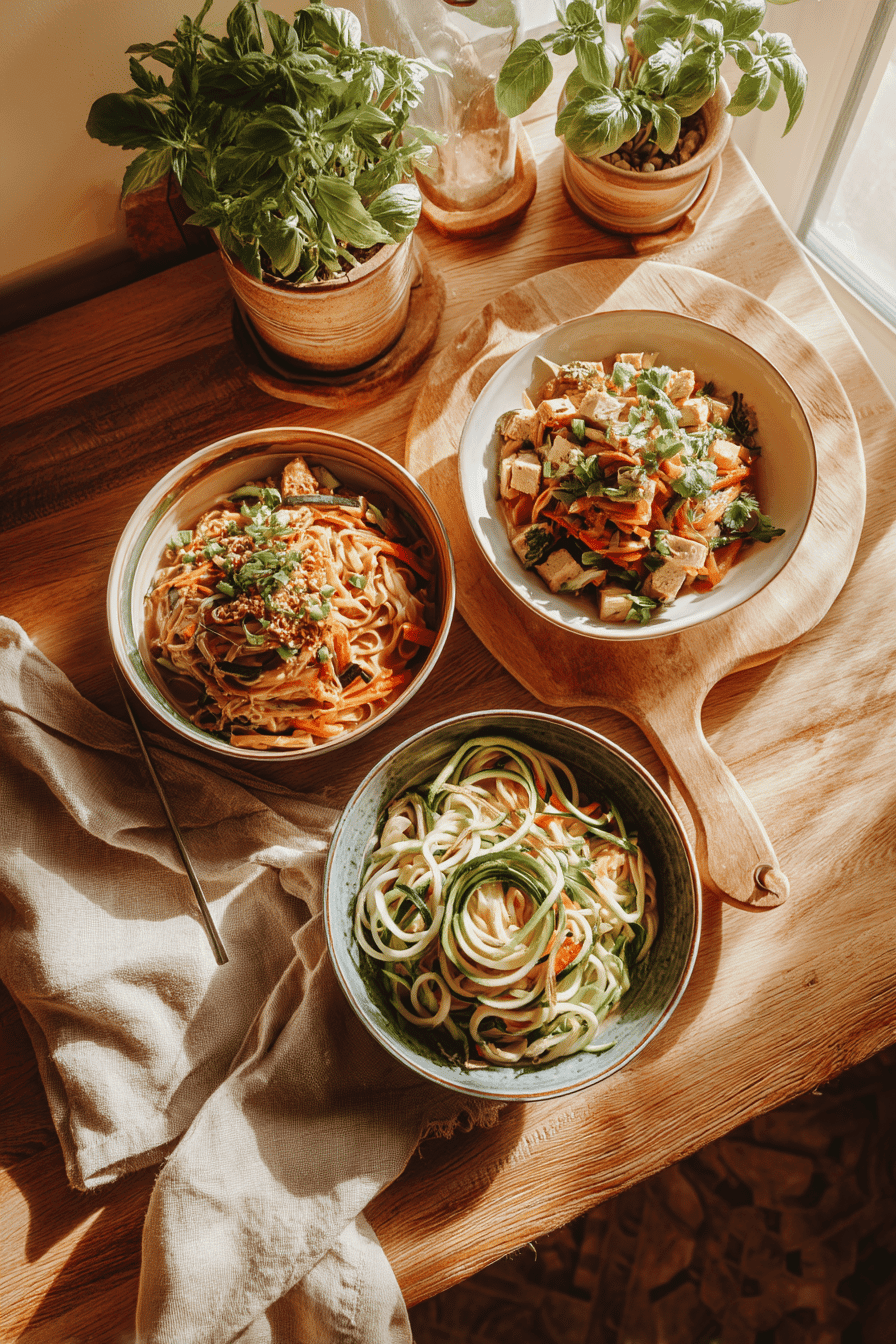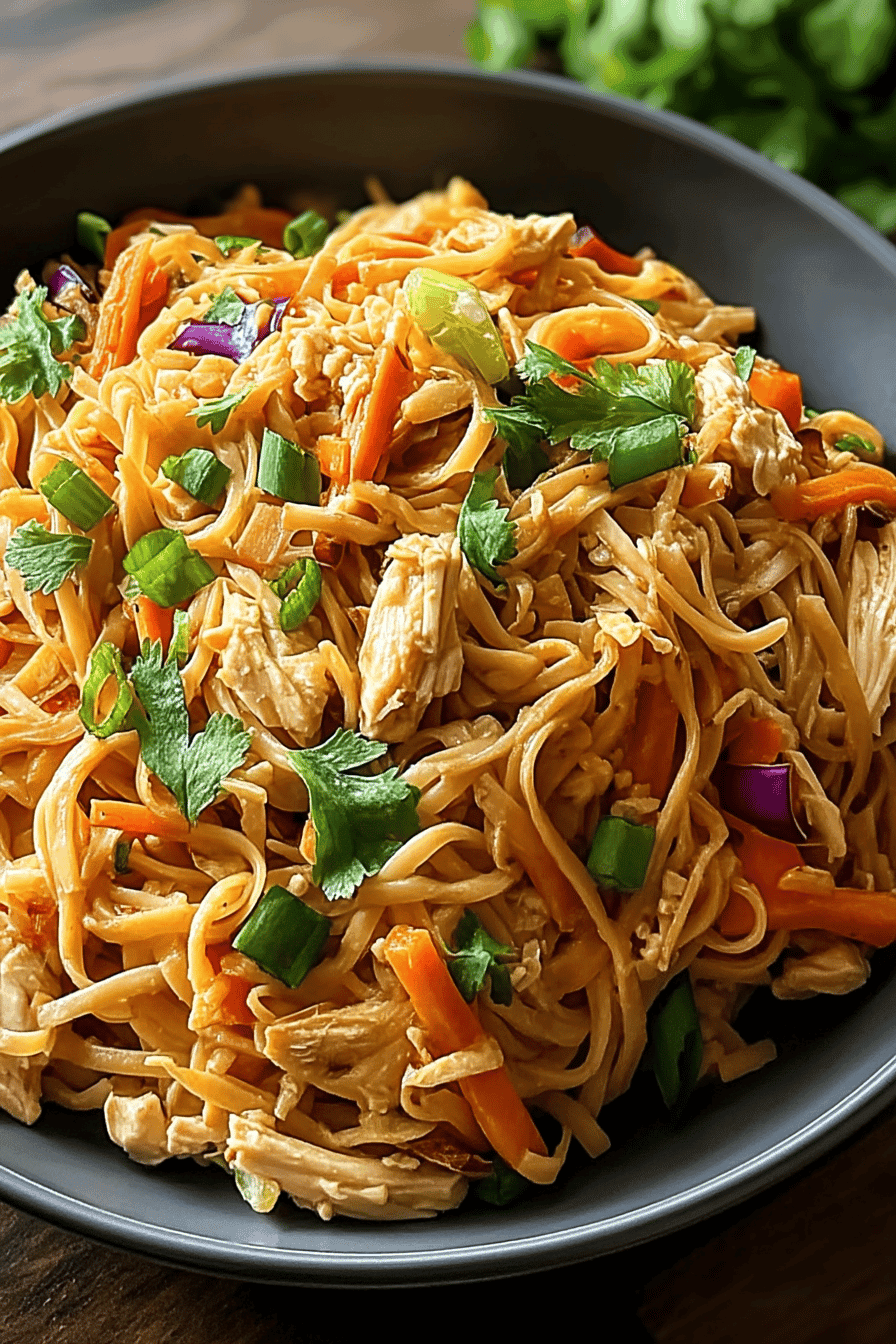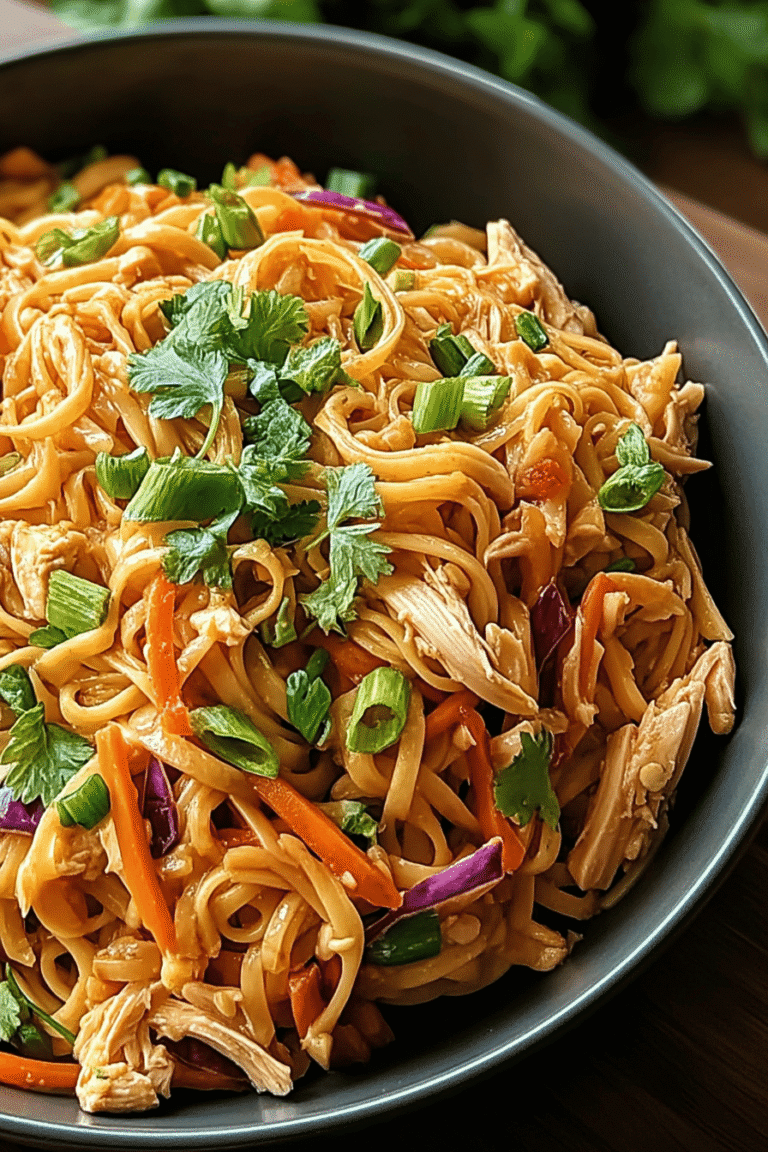Benefits and Advantages of Thai Peanut Noodles
Thai peanut noodles offer an appealing blend of flavors and nutrition, making them a popular option for a quick, satisfying meal. One of the main benefits is ease of preparation; with minimal ingredients and simple steps, the recipe is ideal for busy weeknights or quick lunches. The creamy peanut sauce provides both rich flavor and plant-based protein, alongside healthy fats that support satiety and energy.
This dish is versatile and adaptable, accommodating vegan, vegetarian, and gluten-free diets by simply choosing alternate ingredients like tamari or rice noodles. The inclusion of fresh vegetables increases the nutritional value, contributing vitamins, minerals, and dietary fiber, which supports digestion and overall health.
Carbohydrate-rich noodles provide sustained energy, while the balanced combination of protein and fats from peanut butter ensures feeling full longer. The bold flavors combining savory, tangy, and slightly spicy notes make Thai peanut noodles a flavorful dish that appeals to a wide range of palates.
Whether served warm or chilled, Thai peanut noodles offer a wholesome, tasty, and quick meal option that fits well within diverse dietary lifestyles.
Jump to:
- Benefits and Advantages of Thai Peanut Noodles
- Essential Ingredients for Thai Peanut Noodles
- Dietary Substitutions to Customize Your Thai Peanut Noodles
- Gluten-Free Options
- Vegan and Plant-Based Variations
- Low-Calorie and Low-Carb Adjustments
- Nut Allergy Considerations
- Spice Level Modification
- How to Prepare the Perfect Thai Peanut Noodles: Step-by-Step Guide
- Mastering Thai Peanut Noodles: Advanced Tips and Variations
- How to Store Thai Peanut Noodles: Best Practices
- Nutritional Value of Thai Peanut Noodles
- FAQs: Frequently Asked Questions About Thai Peanut Noodles
- What ingredients do I need to make authentic Thai peanut noodles?
- How can I make Thai peanut noodles spicy without overpowering the dish?
- Can I make Thai peanut noodles gluten free?
- How long do Thai peanut noodles last when stored in the refrigerator?
- Can I add vegetables or protein to Thai peanut noodles?
- Easy Thai Peanut Noodles Recipe for Quick and Flavorful Meals
- Ingredients
- Instructions
- Last Step:
- Notes
- Nutrition
- Did you make this recipe?
Essential Ingredients for Thai Peanut Noodles
The success of Thai peanut noodles depends on fresh, quality ingredients that create a harmonious flavor profile:
- 8 ounces noodles (spaghetti, rice noodles, linguine, udon, or lo mein)
- 1/2 cup natural peanut butter (unsweetened for better control of sweetness)
- 1/2 cup water or chicken/vegetable broth for richer flavor
- 1/4 cup low-sodium soy sauce or tamari (gluten-free option)
- 2 cloves garlic, minced
- 2 tablespoons fresh lime juice or rice vinegar
- 3 tablespoons agave syrup, brown sugar, or honey
- 1 teaspoon Sriracha or chili paste (adjust spice to taste)
- Optional: 1 teaspoon sesame oil, 1/4 teaspoon ground ginger, fresh grated ginger for sautéing
- 1 cup shelled edamame
- 1/2 cup chopped cucumbers
- 1 cup shredded carrots
- 1 red bell pepper, thinly sliced and seeded
- 2 green onions, chopped
- 1/4 cup chopped fresh cilantro
- 1/4 cup chopped peanuts
- Optional proteins: 2-3 ounces cooked shrimp, grilled chicken, or steak
- Optional garnishes: lime wedges, extra chopped peanuts, additional Sriracha, chili crisp oil, toasted sesame seeds
Each ingredient adds unique texture and flavor: noodles provide substance, peanut butter makes the sauce creamy and protein-rich, citrus adds brightness, and fresh vegetables contribute crunch and nutrition.

Dietary Substitutions to Customize Your Thai Peanut Noodles
Thai peanut noodles can be easily adapted to fit a variety of dietary preferences and restrictions:
Gluten-Free Options
- Replace soy sauce with gluten-free tamari or coconut aminos.
- Use rice noodles or gluten-free pasta alternatives.
Vegan and Plant-Based Variations
- Swap honey for maple syrup or agave nectar to keep sweetness from plant sources.
- Add tofu, tempeh, or edamame for plant-based protein boosts.
Low-Calorie and Low-Carb Adjustments
- Use spiralized zucchini or shirataki noodles instead of traditional noodles.
- Reduce the quantity of sugar substitutes or use zero-calorie sweeteners.
Nut Allergy Considerations
- Substitute peanut butter with sunflower seed butter or tahini to maintain creaminess without peanuts.
Spice Level Modification
- Adjust chili paste or Sriracha amounts to taste, starting with small quantities to avoid overpowering heat.
These substitutions enable making Thai peanut noodles accessible and enjoyable for diverse dietary needs without compromising the dish’s characteristic flavor and texture.
How to Prepare the Perfect Thai Peanut Noodles: Step-by-Step Guide
Follow these steps to create flavorful Thai peanut noodles with authentic taste and balanced texture:
- Cook the noodles: Boil rice noodles (or preferred noodles) according to package instructions until al dente. Drain and rinse with cold water to stop cooking and prevent sticking. For gluten-free or low-calorie versions, cook zucchini or shirataki noodles accordingly.
- Make the peanut sauce: In a bowl, whisk together natural peanut butter, soy sauce or tamari, lime juice or rice vinegar, minced garlic, grated ginger, and sweetener (agave syrup, brown sugar, or honey) until smooth and creamy. Add water or broth to achieve desired consistency. Adjust seasoning by taste.
- Toss noodles with sauce: Combine the cooked, cooled noodles with the peanut sauce in a large bowl, stirring well to ensure an even coating.
- Add fresh vegetables: Mix in cooked edamame, chopped cucumbers, shredded carrots, sliced red bell pepper, green onions, cilantro, and chopped peanuts for texture and freshness.
- Incorporate protein (optional): Add grilled chicken, cooked shrimp, or steak slices if desired for enhanced nourishment and flavor.
- Garnish and serve: Sprinkle toasted sesame seeds, extra peanuts, and chili flakes or Sriracha as preferred. Lime wedges and chili crisp oil provide additional flavor layers.
- Serve: Enjoy immediately for optimal flavor and texture, or chill for a refreshing cold noodle salad with vibrant taste.
With simple steps and fresh ingredients, this Thai peanut noodles dish is ready in about 15-20 minutes, perfect for a quick, nutritious meal packed with bold flavors.
For further insights into making delicious peanut sauce, see How to Make Peanut Sauce.

Mastering Thai Peanut Noodles: Advanced Tips and Variations
To master Thai peanut noodles, start by selecting high-quality natural peanut butter without added sugars or hydrogenated oils. For a richer and more aromatic sauce, lightly toast raw peanuts and blend them into the mixture. Experiment with adding coconut milk or almond milk to achieve a creamier sauce with subtle depth without overpowering the peanut flavor. Fresh herbs such as cilantro or Thai basil can be stirred in or used as garnishes to introduce bright, herbal notes. For a spicy punch, incorporate thinly sliced fresh red chilies or adjust the amount of Sriracha to taste. Crunchy vegetables like snap peas or cucumber add pleasing texture contrast, while swapping rice noodles for rice vermicelli provides a lighter, delicate noodle option. For a one-pot meal, try stir-frying the vegetables and protein before combining with the noodles and sauce, which can add wonderful caramelization and complexity. These tips and variations allow you to customize your Thai peanut noodles for diverse taste preferences and occasions.
How to Store Thai Peanut Noodles: Best Practices
Proper storage is essential to maintain the fresh, creamy texture of Thai peanut noodles. Refrigerate leftovers in an airtight container once cooled to room temperature. They can be stored for up to three days safely, though freshness is best within the first 48 hours. For longer storage, freeze the noodles separately from fresh vegetables, as freezing can compromise the texture of raw veggies. When reheating, warm gently in the microwave or on the stovetop over low heat, adding a splash of water or extra peanut sauce to restore creaminess and prevent drying. Avoid reheating multiple times to keep flavors vibrant and textures intact.
Nutritional Value of Thai Peanut Noodles
Thai peanut noodles offer a balanced nutritional profile featuring wholesome carbohydrates, plant-based protein, and healthy fats. Per serving (approximately one-quarter of the recipe), expect calories between 386 to 471 kcal. The peanut butter provides monounsaturated fats and protein essential for sustained energy and heart health. Rice noodles supply easily digestible carbohydrates, while the fresh vegetables contribute fiber, vitamins A and C, and antioxidant compounds, supporting immune health and digestion. Sodium content can vary but may be lowered by using reduced-sodium soy sauce or tamari. Incorporating protein options like tofu or grilled chicken can boost protein intake further, making this dish a satisfying meal. This blend of nutrients makes Thai peanut noodles a flavorful and nourishing choice for a quick meal.

FAQs: Frequently Asked Questions About Thai Peanut Noodles
What ingredients do I need to make authentic Thai peanut noodles?
How can I make Thai peanut noodles spicy without overpowering the dish?
Can I make Thai peanut noodles gluten free?
How long do Thai peanut noodles last when stored in the refrigerator?
Can I add vegetables or protein to Thai peanut noodles?

Easy Thai Peanut Noodles Recipe for Quick and Flavorful Meals
🥢 Dive into these vibrant Thai Peanut Noodles for a burst of flavors that pack a creamy, satisfying punch in every bite.
🥜 Perfect for busy days, this dish effortlessly delivers a quick yet gourmet meal that’s both nutritious and delicious!
- Total Time: 20 minutes
- Yield: 4 servings 1x
Ingredients
Peanut Sauce:
1/2 cup natural peanut butter
1/2 cup water (or chicken/vegetable broth for richer flavor)
1/4 cup low-sodium soy sauce or tamari for gluten-free option
2 cloves garlic, minced
2 tablespoons fresh lime juice or rice vinegar
3 tablespoons agave syrup or brown sugar (or honey)
1 teaspoon Sriracha or chili paste (adjust to taste)
Optional: 1 teaspoon sesame oil, 1/4 teaspoon ground ginger, fresh grated ginger for sautéing
Main Dish:
8 ounces spaghetti, rice noodles, linguine, or Asian noodles (such as udon or lo mein)
1 cup shelled edamame
1/2 cup chopped cucumbers
1 cup shredded carrots
1 red bell pepper, seeded and thinly sliced
2 green onions, chopped
1/4 cup chopped fresh cilantro
1/4 cup chopped peanuts
Optional protein: 2-3 ounces cooked shrimp, grilled chicken, or steak
Optional garnishes: lime wedges, extra chopped peanuts, additional Sriracha, chili crisp oil, toasted sesame seeds
Instructions
1. Whisk together all peanut sauce ingredients in a bowl until smooth. For deeper flavor, sauté minced garlic and fresh ginger briefly in a bit of oil before adding other sauce ingredients and simmer gently for 2-3 minutes to thicken.
2. Cook noodles according to package instructions, then drain and set aside.
3. Combine cooked noodles in a large bowl with edamame, cucumbers, carrots, bell pepper, green onions, cilantro, and peanuts.
4. Pour the peanut sauce over and toss thoroughly to coat all ingredients. Add optional protein if desired.
5. Serve immediately, garnished with lime wedges, extra chopped peanuts, and additional spicy sauce if preferred.
Last Step:
Please leave a rating and comment letting us know how you liked this recipe! This helps our business to thrive and continue providing free, high-quality recipes for you.Notes
🌿 Use gluten-free tamari and rice noodles for a gluten-free dish.
👌 Sauce can be made in advance and stored refrigerated for 3-4 days; rewarm gently and add water or broth if thickened.
🌶️ Adjust spiciness by varying Sriracha or chili paste amounts, starting low and increasing to taste.
- Prep Time: 15 minutes
- Cook Time: 5 minutes
- Category: Main Course
- Method: Boiling, Tossing
- Cuisine: Thai
- Diet: Vegetarian
Nutrition
- Serving Size: 1/4 recipe
- Calories: 471
- Sugar: 16 g
- Sodium: 950 mg
- Fat: 19 g
- Saturated Fat: 4 g
- Carbohydrates: 60 g
- Fiber: 7 g
- Protein: 19 g







